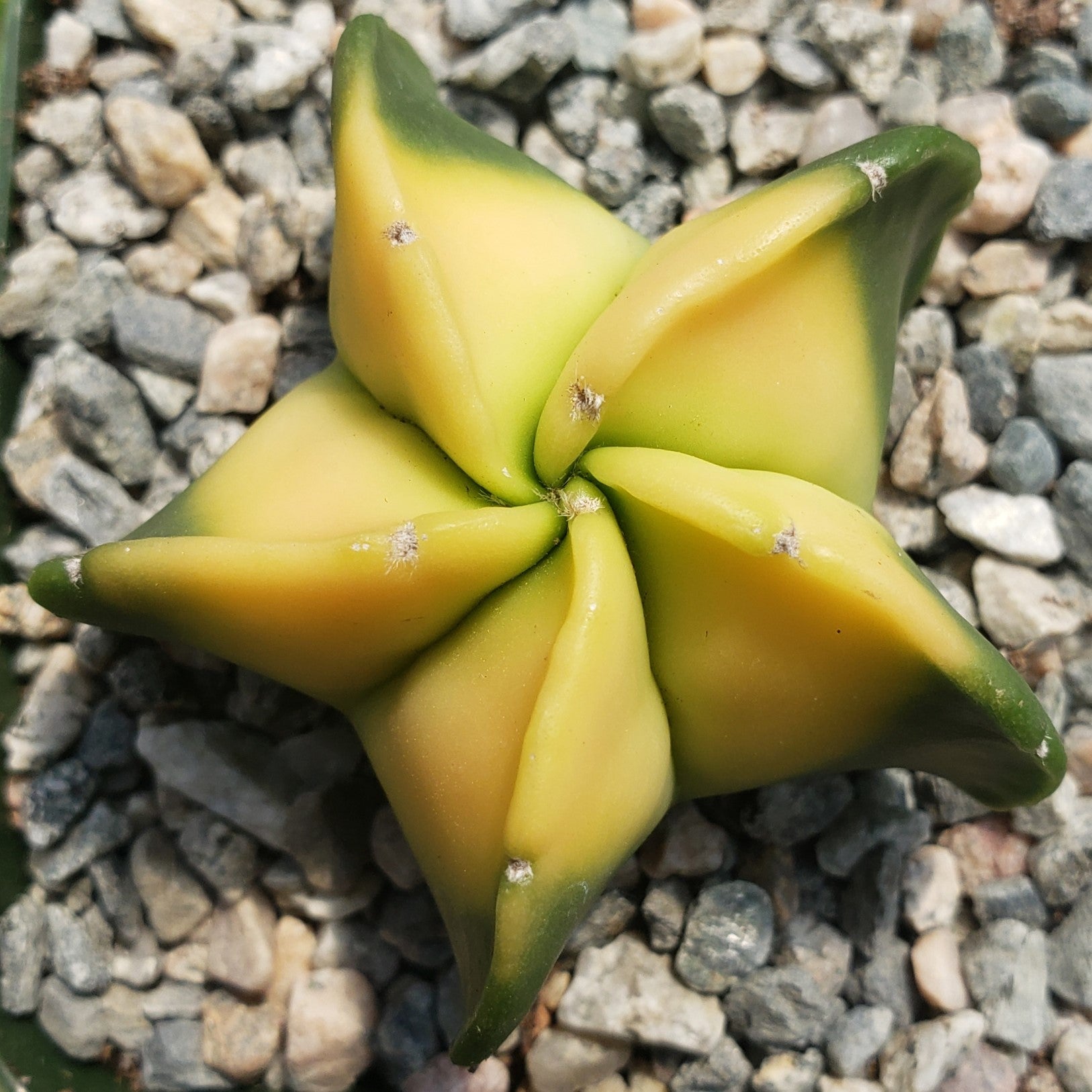Everything to know about Astrophytum Myriostigma (Bishop's Cap)
Updated: May 03, 2024

If you are looking for an exciting and extraordinary spineless cactus, go for the Astrophytum Myriostigma plant. Native to Mexico, the Astrophytum myriostigma has several other common names, such as Bishop’s Cap Plant, Bishop’s Hat, Bishop's Miter, Monk's Hood, Deacons Hat, or Star Cactus.
This Bishop's cap cactus variety is loved by people for its easy-going nature. It makes a superb addition to your indoor as well as outdoor spaces. However, to flaunt it at your place, place it on windowsills, bookshelves, or desks.
If you wish to learn how to grow and care for Bishop's cap cactus, this blog is the best guide for you. It will take you through minute details for cultivating and caring for this charming star-like cacti.
Characteristics of Astrophytum Bishop's Cap Cactus

Bishop’s hat is an exclusive houseplant that comes from the highlands of northeastern and central Mexico and the flowering cactus family of Cactaceae.
It features a star-like appearance which has got its name “Astrophytum”, which means “star plant” in Greek.
Additionally, as it grows taller and older, its ribs are covered with hairy and white spots that look like the traditional headdress donned by bishops, due to which it is also famous as the bishop’s miter.
This species of Astrophytum myriostigma
experiences slow growth but is relatively simple and easy to grow.
Being a tall species of cactus, it can reach from 70 to 100 cm in height. They can have 3 to 7 bulky and vertical ribs. However, they usually have five non-spiky ribs.
In their habitat, their cylindrical to globular stems are covered with the noticeable white mob of trichomes. Some varieties may lack these spots.
The Bishop's cap cactus flowers may take up to 6 years to bloom but the wait is worth it! Its daisy-like flowers come in different colors having yellow, pink-violet, or creamy white base and a red, orange, or creamy yellow center.
How To Grow & Care for Astrophytum Myriostigma (Bishop's Cap)
Quick Reference

Bloom Season

Flower Color

Growth Rate

Hardiness Zone

Mature Size

Plant Type

Sun Exposure

Toxicity

Watering Needs
This cactus species is easy to grow and care for. Here is a detailed guide for you so you can do proper Astrophytum myriostigma care and face no challenges while growing it.
Bishop's Cap Light Requirements
The myriostigma cactus needs to be placed in bright and indirect sunlight for a minimum of 6 hours every day. If you live in a place with cooler climates and where sunlight is not too harsh then only you can put it in full sunlight. When cultivating it inside your home, place it on a south-facing windowsill and use sheer curtains to save it from direct sunlight.
Optimal Soil for Bishop's Cap
They will be happy if planted in well-drained, sandy soil. A commercial cactus potting mix will ensure great Bishop's cap succulent care. You can even DIY your soil mixture by mixing a quarter of pumice and coarse sand each, and 50% potting soil. This mixture will have excellent drainage and your star cacti will appreciate it.
Bishop's Cap Watering Needs
If you are among those who forget to water their beloved plants then Bishop’s hat is the right choice for you. This pretty cactus has conservative watering needs and can survive easily when watered occasionally during summer. The best time to water it is when the soil is dry. During the winter season, avoid watering as moisture retention can lead to root rot.
Optimal Temperature for Bishop's Cap
Astrophytum bishop's cap requires a little cooler to moderately-warm temperature within USDA hardiness zones 10 to 11. If exposed to long hours of frost, they will immediately die so do not keep them in temperatures below -6°C (21.2°F).
Best Fertilizer for Bishop's Cap
This cactus does not require fertilizer to thrive. However, if you still wish to feed them with fertilizer, the ideal fertilizing time is once every month from summer to the initial signs of winter coming. Make sure you use a diluted liquid fertilizer with low nitrogen levels.
Bishop's Cap Cactus Propagation
Use Astrophytum myriostigma seeds for quick and hassle-free propagation. Instead of purchasing its seeds from any nursery, it is best to collect them from its dried flowers. To let it germinate ideally, put the seeds in loamy and well-draining soil, and offer it light moisture, and indirect sun exposure. Once germination begins and little growth is noticeable, you can transplant that baby Bishop’s hat into a separate porous pot.

Potting & Repotting of Astrophytum myriostigma
When it comes to buying an ideal pot for this cactus, choose the ones designed from permeable material for excellent drainage. Ensure the best Astrophytum myriostigma care with a terracotta, clay, or ceramic pot.
Usually, your star cactus can stay happily in the same pot for around 4-5 years. So, repotting is a breeze. To repot, carefully remove the cactus from the pot and remove any loose soil from its roots along with any dead roots. You can either get a new pot or use the old one for repotting. However, you need a fresh potting soil mix for successful repotting. Compress the soil gently and water it.
Bishop's Cap Plant: Toxicity, Common Pests & Diseases

This charming Bishop's Cap Cactus is non-toxic to pets and human beings. Therefore, it can be planted in your home garden. However, it can be a point of attraction for scale insects and mealybugs. They can easily hide under the hairy areolas, so keep an eye on them and treat them on time with a suitable insecticide.
Regular monitoring and appropriate pest control measures can help prevent and manage these issues. It will maintain the beauty of your star cactus!
Ideal for both internal and external spots, Astrophytum Bishop's Cap is one of the most loved cacti. Astrophytum myriostigma will improve the aesthetics of your container garden or rock garden.
Where to Buy Astrophytum myriostigma?
When it comes to buying Bishop's Cap Astrophytum myriostigma, you might be able to find it at local nurseries or garden centers in your area that specialize in succulents and cacti. But Planet Desert is your easiest and best option if you're looking to buy affordable cacti online and have them conveniently shipped right to your door!
Here is the link to our product page for Astrophytum myriostigma. Here at Planet Desert, we have a large selection of over 500 cacti & succulents in stock and ready to ship nationwide. We guarantee that all our plants are of high quality and will arrive happy and healthy.
Growers Reference Guide - Astrophytum myriostigma
| Bloom Season | Summer |
|---|---|
| Botanical Name | Astrophytum myriostigma |
| Common Name | Bishop's Cap |
| Dormancy | Winter |
| Family | Cactaceae |
| Flower Color | Pale Yellow--Golden white |
| Genus | Astrophytum |
| Growth Habit | Globular |
| Growth Rate | Slow |
| Hardiness Zone | 10--11 |
| Mature Size | 8-40 in. tall--8 in. wide |
| Native Area | Mexico |
| Plant Type | Perennial cactus |
| Propagation | By seeds |
| Resistance | Drought tolerant--mild frost tolerant--deer resistant |
| Soil PH | 6.5--Acidic--Neutral |
| Soil Type | Cactus potting mix soil |
| Special Features | Easy to maintain--Showy Blooms |
| Sun Exposure | Full sun--partial shade |
| Toxicity | Safe for humans--friendly to dogs--friendly to cats |
| Watering Needs | Low |
The Bottom Line
Overall, the Bishop's Cap cactus (Astrophytum myriostigma), is a captivating cactus species known for its unique shape and increasing number of ribs as it matures. This cactus is relatively easy to care for, making it a great choice for both experienced plant enthusiasts and beginners. It thrives in well-draining soil and requires bright, indirect light. Now that you have gone through the Bishop's Cap care guide, bring this attractive Astrophytum myriostigma home and add great vibes to your space.
>> Buy Astrophytum Myriostigma (Bishop's Cap) Here at Planet Desert
Frequently Asked Questions
-
How do you take care of Astrophytum myriostigma?
Astrophytum myriostigma (Bishop's Cap cactus) is a low-maintenance cactus that thrives in bright, indirect light, so make sure to place it near a sunny window. When it comes to watering your Astrophytum myriostigma, allow the soil to dry out completely between waterings, and be cautious not to overwater. During the winter months, reduce watering even further. As for the temperature, this Bishop’s cap cactus prefers warm conditions, ideally between 50 and 55°F. Additionally, use well-draining soil and avoid excessive fertilization.
-
What is the minimum indoor temperature for Astrophytum myriostigma?
The minimum indoor temperature for Astrophytum myriostigma (Bishop's Cap cactus) should be around 50–55 °F. It's important to keep this cactus in a warm environment to ensure its optimal growth. If the temperature drops below this range, it might cause harm to the plant. So, make sure to keep it cozy and warm!
-
How do you propagate bishops cap?
Bishop's Cap cactus, or Astrophytum myriostigma, is primarily propagated from seeds. You can collect the seeds from mature fruits or purchase them from a reputable source. If you are in one of USDA zones 10 through 11, you can cultivate Astrophytum seeds outside. In colder climates, you can start indoor sowing on a seed mat or under a grow lamp. To propagate from seeds, sow them in well-draining soil and lightly cover them. Keep the soil slightly moist and provide bright, indirect light. With time and proper care, the seeds should germinate, and you'll have new Bishop's Cap cacti sprouting up.
-
How big does Bishop's Cap Cactus get?
The Bishop’s Cap cactus (Astrophytum myriostigma) can grow to be about 8–40 inches tall and 4–8 inches wide. It has a unique shape, resembling a bishop's miter or hat, which gives it its name. As the cactus matures, it develops more pronounced ribs, which are vertical lines or ridges that run along its body. These ribs increase in number and become more prominent with age, adding to the cactus's distinctive appearance. It's a relatively small cactus compared to some others, but it can still make a beautiful addition to your plant collection.


Leave a comment